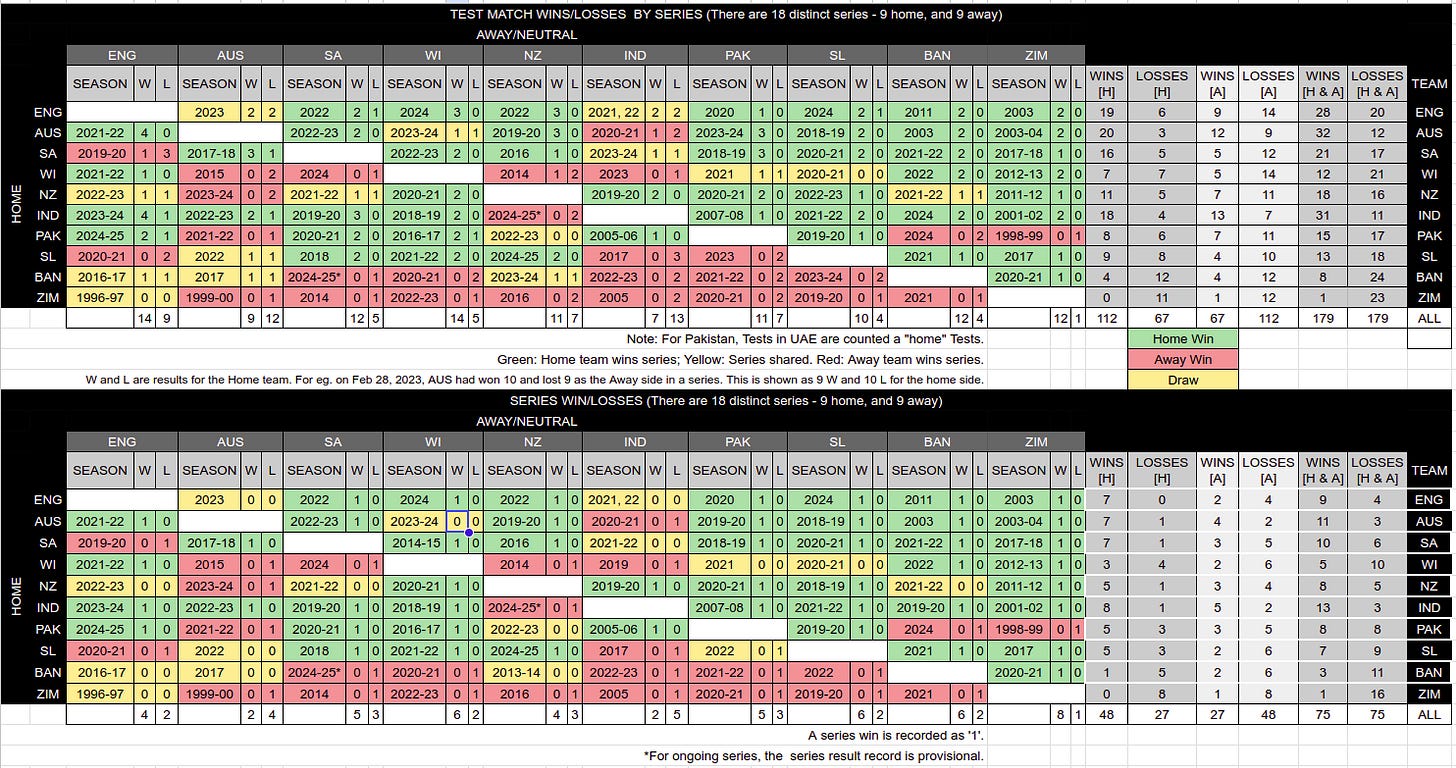The greatest home winning streak in Test history came to an end today. New Zealand beat India by 113 runs at the MCA stadium in Pune, thanks to Mitchell Santner’s thirteen wicket haul. At Bangalore, New Zealand played Matt Henry, found a seamer, and he took 8 wickets in the match. At Pune, New Zealand played Santner on a turner, won a very good toss, and he took 13/157. As a sequence of selections, along with India’s introduction of Washington Sundar (11/115), its hard to top these over two Tests.
New Zealand won an important toss. The ball turned more as the match progressed. It also turned more when the speed was in the 80s than when it was in the 90s. The margin of victory was nearly what New Zealand scored in the first two sessions of the match. New Zealand lost their last 17 wickets in the match for 316 runs even though 10 of those wickets were spent with a 103 runs first innings lead on the board which forced India to defend runs with their field settings a lot more than they would have liked to.
Santner was not the most accurate bowler in the match. He hit a good length 64% of the time. He collected 9/65 from the 185 balls he bowled on a good length. His speed was slower than that of Ashwin, Jadeja or Sundar, and he turned the ball more than them. Even when he missed his length, Santner collected 4/91 [104 balls]. Washington Sundar hit a good length 68% of balls and collected 6/68 from these. Like Santner - 3/45 [63 balls] - , he also collected wickets from the fuller length 4/40 [68 balls]. It is perhaps not a surprise Glenn Phillips observed in his post-match interview that “[Santner] was having a golden run…. Whatever he touched turned to gold”.
Ashwin hit a good length 71% of the time. When he erred, it was mostly on the full side (0/49 in 65 balls). Since the beginning of the series against England, the great man has been worried by the sweep and the reverse-sweep. Against England, as the series wore on, England’s luck with the sweep ran out. Spinners tend to bowl fuller when the batter is prone to sweeping. It worked brilliantly for India against the visiting Australians in 2023. What’s changed in the last couple of years, and especially in 2024 for the Indian spinners is that its no longer just the odd player in a batting line up who plays the sweep and the reverse-sweep. Nearly every batter in the line up does it now. Spinners have been trying to work out how to counter this, because, while it produces batting collapses, it also occasionally produces a lot of runs quickly.
There is a theory that Santner slowed it down and got more turn, at least as a variation, and that this was why he got more wickets than Ashwin or Jadeja. Perhaps. But the simpler explanation, perhaps, is the one offered by Phillips - he just had a great run. This was probably also true in the case of Washington Sundar.
These types of returns are part of the game. New Zealand had a theory of how they were going to get 20 Indian wickets on this Pune pitch, and it worked out well for them. It helped that New Zealand got Rishabh Pant on one which kept low enough to beat his pull shot in the first innings and on a run out in the second. The ball which dismissed Pant was pitched on a 6.2m length and hit the stumps 53 cms above the ground. The 40 balls which pitched on a 6m length in the second innings of this Test crossed the stumps, on average 68cms above the ground. For New Zealand Tom Latham, who had been dismissed to great deliveries in this series so far, made a fine 86 as New Zealand cobbled together enough runs to extend their lead past 350. As in the first Test, India’s bowlers created more jeopardy than New Zealand’s. They induced a false shot every 5 balls to one every 5.5 balls induced by New Zealand’s bowlers. But the dismissals went in New Zealand’s favor.
India’s streak has been broken emphatically, with seam and spin. Much will be made of the Indian players weakness against seam bowling and spin bowling. These points are non-starters as serious points. No team can win as much as India has if it’s batting was bad enough to have problems against seam and spin. They’ve played, essentially, on 10 result pitches in the 2024, and won 7 of them - 1 in South Africa and 6 in India. These results have come using 22 different players. The eleven which played in Pune had six players aged 27 or below, and 4 players aged 35 or older. Only Jasprit Bumrah, at age 30, can be considered to be anywhere near “peak” age. Regardless of the results, at least four regulars in Indian Test team are likely to change sooner rather than later.
New Zealand have now won five of their last 7 Tests against India. Currently, they have beaten India home and away. The chart below shows the most recent home and away series for each team (the spreadsheet can be viewed here). It is a marvellous achievement by a marvellous team.









Shouldn’t the NZ v SA at home be 2-0 from the 2023-24 series?
Briliantly Written.